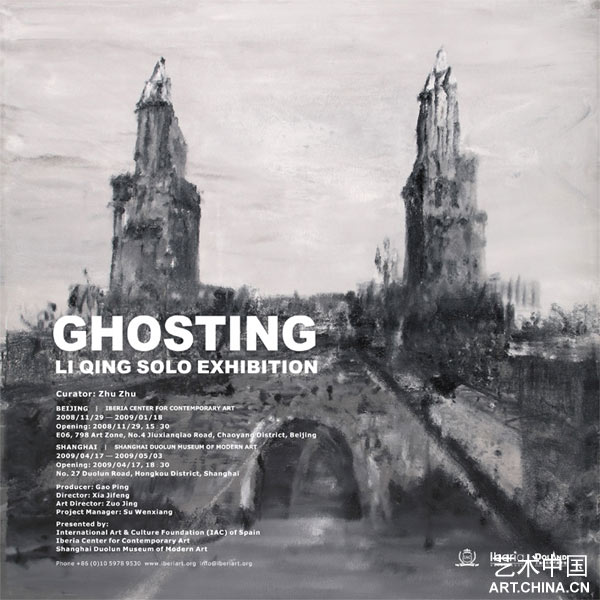
重影:李青個(gè)展
開幕:2008年11月29日,下午三點(diǎn)半
展期:2008年11月29日– 2009年1月18日
地點(diǎn):伊比利亞當(dāng)代藝術(shù)中心
地址:中國(guó)北京市朝陽區(qū)酒仙橋路4號(hào)798藝術(shù)區(qū)E06
主辦:伊比利亞當(dāng)代藝術(shù)中心,西班牙國(guó)際文化藝術(shù)基金會(huì)
策展人:朱朱
藝術(shù)家:李青
出品人:高平
總監(jiān):夏季風(fēng)
藝術(shù)總監(jiān):左靖
項(xiàng)目負(fù)責(zé):蘇文翔
www.iberiart.org
展覽簡(jiǎn)介:
伊比利亞當(dāng)代藝術(shù)中心向您隆重地介紹2008年11月29日將于本中心開幕的“重影:李青個(gè)展”。1981年出生的李青畢業(yè)于中國(guó)美術(shù)學(xué)院油畫系,2005年南京博物院舉行的第二屆中國(guó)藝術(shù)三年展上,一組名為《大家來找茬》的系列作品使他獲得了最初的贊譽(yù)并從此嶄露頭角。與所有中國(guó)新一代藝術(shù)家面臨的問題一樣——即如何處理固有的社會(huì)現(xiàn)實(shí)經(jīng)驗(yàn)與逐步加深的全球化體驗(yàn)之間的摩擦與融合。而李青的作品在關(guān)注以上問題的同時(shí)也沒有放棄對(duì)藝術(shù)史內(nèi)部邏輯的思考,尤其是對(duì)繪畫本體性的連續(xù)追問。最初的“找茬”系列在富于游戲感的形式之下對(duì)于畫面機(jī)智并具反諷意味的處理將觀者帶到關(guān)于藝術(shù)和現(xiàn)實(shí)經(jīng)驗(yàn)的雙重思考之中,籍此我們可以說李青重啟了繪畫與觀者之間的互動(dòng)模式。目前,這一系列里的作品之一《婚禮》正在倫敦薩奇畫廊一個(gè)名為“革命在繼續(xù):中國(guó)新藝術(shù)”的展覽中展出。
李青對(duì)于“互動(dòng)”模式的探求進(jìn)而體現(xiàn)在他對(duì)繪畫行為本身的實(shí)驗(yàn)。相對(duì)于以往的“找茬”,在新的名為《互毀而同一的像》系列作品之中,顯得更加極端和具有觀念性,他將兩件尚未干透的畫面進(jìn)行粘合,然后再分開,從而產(chǎn)生出兩張全新的圖像,粘合的行為本身是破壞性的,卻導(dǎo)致了圖像之間的“同一”。李青還把對(duì)繪畫語言探索的經(jīng)驗(yàn)開拓到新的媒介,名為《乒乓》的錄像裝置將“互毀”這一行為交由觀眾實(shí)施,從而使觀眾參與到作品有關(guān)文明之間的沖突與滲透主題的闡釋過程中,這也正是展覽的主題“重影”的寓意所在。
本次展覽除了展出《找茬》、《互毀而同一的像》等系列性的繪畫,還將展出錄像、裝置、攝影等多種媒介的創(chuàng)作共計(jì)三十余件,從而使您能夠深入認(rèn)識(shí)這位將觀念與語言進(jìn)行了罕見而出色的結(jié)合的中國(guó)最新一代中的代表性人物。

Ghosting: Li Qing’s Solo Exhibition
Opening: 29th, Nov, 2008, 15:30
Exhibition Duration: 29th, Nov, 2008 - 18th, Jan, 2009
Venue: Iberia Center for Contemporary Art
Address: E06, 798 Art District, No.4 Jiuxianqiao Road, Chaoyang District, Beijing,China
Presented by:
The International Art & Culture Foundation (IAC) of Spain
Iberia Center for Contemporary Art
Curator: Zhu Zhu
Producer: Gao Ping
Director: Xia Jifeng
Art Director: Zuo Jing
Project Manager: Su Wenxiang
www.iberiart.org
Exhibition Brief:
Iberia Center for Contemporary Art presents “Ghosting: Li Qing’s Solo Exhibition”, which will open at the center on November 29, 2008. Li Qing, born in 1981, graduated from the China Academy of Art Oil Painting Department. He first made his mark with the exhibition of his highly acclaimed Spot the Difference at the Second China Art Triennale, held at the Nanjing Museum in 2005. It addresses the same question faced by all artists of the new generation – how to deal with the frictions and synergies taking place between the established social experience and the deepening effects of globalization. While Li Qing’s works address the above issues, he has not given up on pondering the internal logic of art history, especially the continued pursuit of the essence of painting. The intelligent and satirical arrangement of the picture in earliest “Spot the Difference” leads the viewer to ponder the experience of art and reality, and for this we can say that Li Qing has restarted the interaction between viewer and painting. One work from this series, Wedding, is currently on display at the Saatchi Gallery in London as part of the exhibition “The Revolution Continues: New Chinese Art”.
Li Qing’s exploration into forms of “interaction” is further embodied by his experimentation with the act of painting itself. Compared to his “Spot the Difference” series, Images of Mutual Undoing and Unity is more extreme and conceptual. In this series, he takes two paintings that haven’t dried and sticks them together. When they are pulled apart, two wholly new images are formed. The act of sticking them together is destructive, but it leads to “unity” between the two images. Li Qing has also brought his experience from the exploration of painting language into new mediums. The video installation Ping Pong hands the act of “mutual destruction” to the audience, bringing them into the artwork’s process of expounding on the conflicts and permeation that takes place between two civilizations. This is the root of the exhibition’s name, “Ghosting”.
Aside from presenting the painting series Spot the Difference and Images of Mutual Undoing and Unity, this exhibition will also present approximately thirty works of film, installation and photography, which will give you a deeper understanding of this new generation Chinese artist who has engaged in a rare and exemplary unification of concept and language.
|

